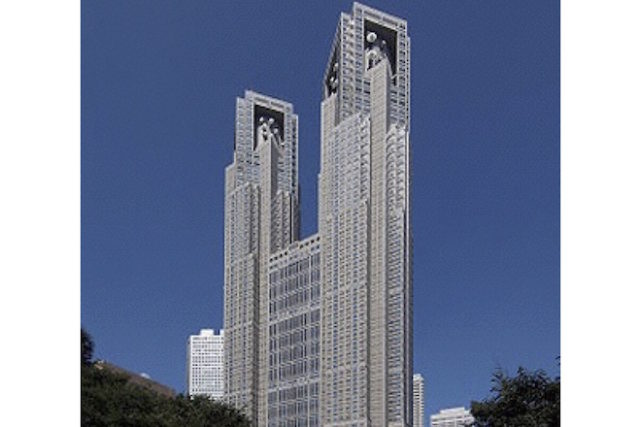By Yukiko Tanaka
Having moved f rom its old location in Marunouchi, the Tokyo Metropolitan Government has its offices now in Shinjuku; it took two-and half years to complete the two 48 floor-high buildings and their towers but they were the tallest buildings in Tokyo. Since then, a few taller buildings, such as Yokohama’s Landmark Tower and Mid-Town in Roppongi have been built, but the Municipal Government Tower Buildings are nonetheless Tokyo’s landmark today.
Tange Kenzo, a well-known architect, designed the Municipal Buildings and imaged them after the Notre-Dame Cathedral in Paris. Not all responses and opinions to these remarkable buildings were positive, however, and they were given ironic, even mean, nicknames such as ‘Tax Towers’ and ‘Towers of Babel.’ Seeing these yet more high-rises that followed several earlier examples nearby, the Tokyo Municipal Buildings, some say, have brought doubt to the minds of those who have seen them all, wondering if such an urban re-development is indeed good for the Japanese and, further, human kind.
The Municipal Buildings with their twin towers nonetheless are new landmarks of Tokyo, attracting many visitors from near and far, particularly with its observatory on the 45th floor enabling a 360-degree view of central Shinjuku. Since this view is truly spectacular, and observatories elsewhere charge an entrance fee, I recommend you to make a quick visit. On its ground floor, furthermore, you can pick up sightseeing information written in foreign languages.
Shinjuku Station’s West Entrance area has seen large-scale re-development prior to the construction of the Metropolitan Government buildings. With high-rise office and hotel buildings along wide, straight streets, this area is primarily for cars to navigate, not for pedestrians to enjoy walking. Luckily, the Metropolitan Buildings have next to them the large open space of Chuo Koen (Central Park). Also, the trees and shrubberies nearby, which are by now all matured, help to reduce the overwhelming feeling that massive concrete buildings give when seen from a short distance.
In fact, I enjoy walking the space surrounding the Metropolitan Tower, and
whenever I am nearby and have extra time on hand, I go there to take a walk. It is not a bad idea to spend a half hour or so wandering and enjoying this urban center, and since there are restaurants in those high-rises catering those who work in innumerable offices, there is a variety of economical lunch menus.
Closer to Shinjuku Station is Keio Plaza Hotel, of which you have a glimpse in the movie, “Lost in Translation.” The camera concentrates on the interior of the hotel, in which two Americans, played by Bill Murray and Scarlett Johansson, found themselves trapped. At least, they feel trapped one way or another, since they are not confident enough to go out f reely.
What is lost in and around this Shinjuku hotel is not just the meaning of a foreign language. If you find yourself feeling lost or in need of a human touch in this jungle of Shinjuku, however, you should go into the Chuo Park nearby and to its children’s playground. You will realize that ordinary families live in the highly developed urban corner as well.
One day, while taking a walk amidst the high-rises, I stumbled upon a small but unusual museum housed in one of them with “Peace Memorial Museum” written at the entry, consisting of three rooms. The first room offers information on Japanese soldiers who were detained and put in hard labor by the Soviet government at the end of the Pacific War with eating utensils, clothes to shield oneself from severe cold and other items that the ex-soldiers made themselves that are interesting to see but also moving at the same time.
That which is shown in the other rooms gives a glimpse of the life of returnees from Northern China at the end of the war and materials showing experiences of ordinary Japanese families sending their men to the battlefields. As far as I know, museums of this nature are not found elsewhere in Tokyo. It is worthwhile to take a quick visit while you are in the West Entrance area of Shinjuku Station.
[Editor’s Note]
This series introduces a historical view of various sites in Tokyo. The writer can be reached at ytanaka03@gmail.com.






